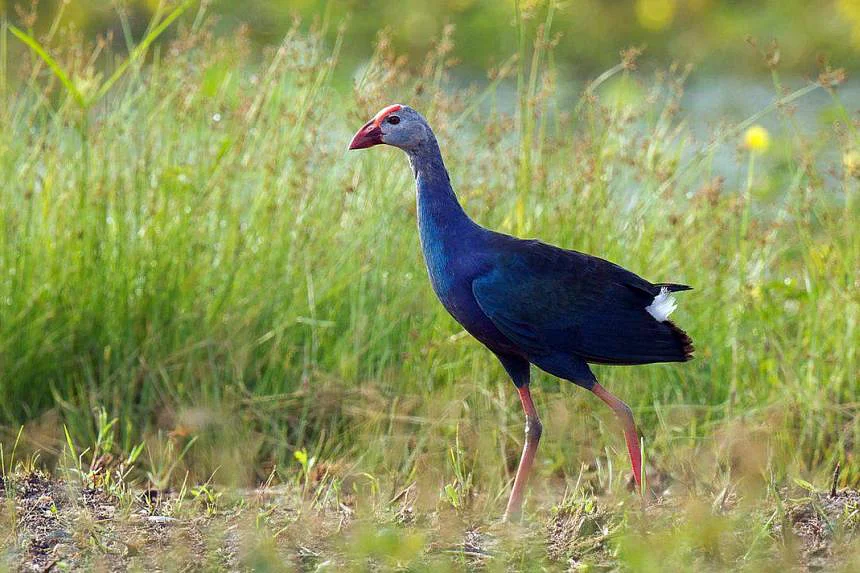November 15, 2022
SINGAPORE – Twenty-four species of birds are bouncing back in Singapore, according to the latest assessment of the conservation status of 413 bird species here published in September.
Another five, however, are more threatened than they were before.
The list was prepared for the third edition of the Singapore Red Data Book by the National Parks Board, which was last updated in 2008.
The Straits Times highlights some of the birds making a comeback and others that have become rarer.
1. Buffy fish owl (Ketupa ketupu)

A buffy fish owl in the Singapore Botanic Gardens on April 2, 2019. ST PHOTO: LIM YAOHUI
The nocturnal bird is now considered vulnerable instead of critically endangered in Singapore, and it lives in forests and mangroves close to water sources.
The raptor with long tawny ear tufts has been recorded in places such as the Central Catchment Nature Reserve, Pulau Ubin and Pasir Ris Mangroves.
The solitary hunter is usually active at dawn and dusk where it can be found close to waterways and urban water bodies.
2. Blue-crowned hanging parrot (Loriculus galgulus)

Blue-crowned hanging parrot. PHOTO: FRANCIS YAP
Once regarded as endangered, the blue-crowned hanging parrot is now of least concern and not a focus of species conservation.
The bird, which grows up to 14.5cm, is known to live in green spaces with trees such as parks and gardens as well as on forest edges.
It has been found in the Singapore Botanic Gardens, Bukit Timah Nature Reserve and forested areas in Bedok, which are slated to make way for the future Bayshore housing precinct.
Male parrots have a luminous green plumage and a reddish breast patch, while females are duller and do not have a reddish breast patch.
The parrot usually eats fruit, nectar, buds and flowers.
3. Violet cuckoo (Chrysococcyx xanthorhynchus)

Violet cuckoo. PHOTO: FRANCIS YAP
The violet cuckoo, often heard than seen, has been downlisted from endangered to vulnerable.
The brood parasite frequents forests, forest edges as well as parks and gardens where it is known to lay eggs in the nests of other birds to get them to raise its young.
It has been sighted at Bukit Batok Nature Park, Pasir Ris Park and Jurong Eco-Garden.
Males are generally glossy purple while females are reddish-bronze.
It feeds on both insects and fruit.
4. Thick-billed green pigeon (Treron curvirostra)

Thick-billed green pigeon. PHOTO: FRANCIS YAP
The clownish-looking pigeon has been categorised as vulnerable instead of endangered.
The thick-billed green pigeon is found in forested areas such as Bukit Timah Nature Reserve, Dairy Farm Nature Park and Bidadari.
The thick-set species is usually seen flying in pairs or small flocks.
Both sexes are mostly green but the female lacks maroon wings.
It usually eats fruit. When a fig tree with ripe fruit is located, flocks of up to 60 have been seen to descend on it to feed with other birds.
5. Grey-headed fish eagle (Haliaeetus ichthyaetus)

Grey-headed fish eagle. PHOTO: FRANCIS YAP
The majestic raptor once thought of as critically endangered in 2008 has been reclassified as vulnerable with its population increasing in recent years.
The grey-headed fish eagle lives in woodland next to water bodies where it has been spotted hunting.
It has been sighted near Sungei Ulu Pandan and around Jurong Lake.
The large raptor tends to perch on vantage points such as bare branches that make for an excellent lookout for an unsuspecting fish or waterbird.
6. Blue-eared kingfisher (Alcedo meninting)

Blue-eared kingfishers. PHOTO: FRANCIS YAP
The bright blue bird, once believed to be critically endangered, has been categorised as endangered.
It lives near streams, ponds and water bodies near forested and wooded areas where it can feed.
The blue-eared kingfisher has been sighted in nature areas including Lorong Halus, Sungei Buloh and Hindhede Quarry.
The male has an all-black bill while the female has a reddish lower jaw.
It eats insects and fish.
7. Chestnut-winged babbler (Cyanoderma erythropterum)

Chestnut-winged babbler. PHOTO: FRANCIS YAP
The petite forest-dwelling bird is categorised as critically endangered, or on the brink of extinction in Singapore, up from endangered in 2008.
It has been found in the central catchment forest and is typically seen foraging in small groups beneath the trees.
Urbanisation has contributed to its dwindling numbers. While some bird species have increased in abundance or occur more widely around Singapore, it does not necessarily mean that ecosystems here are improving. It may be because some of these species are better adapted to the urban and suburban environment, said Dr Yong Ding Li, flyways coordinator at the BirdLife International Asia office in Singapore.
“In contrast, forest dwelling species that depend on relatively undisturbed tropical forests such as the chestnut-winged babbler have been assessed as critically endangered in the recent update,” he added.
The updated list draws on 30 years of annual bird census data by the Nature Society (Singapore) and its volunteers, which helped prepare the list along with organisations including BirdLife International, said Dr Yong.
8. Grey-headed swamphen (Porphyrio poliocephalus)

Grey-headed swamphen. PHOTO: FRANCIS YAP
Once regarded as being near threatened in 2008, the elusive bird has been deemed as critically endangered here.
The grey-headed swamphen inhabits swampy areas that are rare in Singapore amid development.
The bluish bird with a red beak has been sighted in Kranji Marshes feeding while walking on floating vegetation.
Sources: Singapore Birds Project, National Parks Board, eBird


